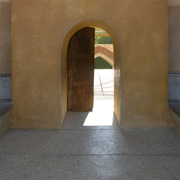
Deir Abu Maqar
The International Carlo Scarpa Prize for Gardens
XVI Annual Award, 2005
The jury of the International Carlo Scarpa Prize for Gardens has decided to dedicate the 2005 Prize to Deir Abu Maqar, the Egyptian monastery of Saint Macarius which, together with Deir el Baramus, Deir Amba Bishoi and Deir es Suriani, makes up a group of Coptic Christian monastic settlements founded in the second half of the IV century in the Wadi en-Natrun, a saltpetre-rich depression on the desert road between Alexandria and Cairo to the west of the Nile delta. The uninterrupted history of Coptic Christian monasticism over a period of seventeen centuries is of crucial importance, also from the point of view of the physical form and life of the places where it developed and flourished.
Their foundation marks one of the later stages of a movement that started in the early centuries of the Christian era with the restive and critical attitude of part of the peasant class, their enthusiastic embracing of the Christian message, their rejection of the existing order and their devising of an alternative based on an ascetic lifestyle pursued outside the social physical framework of the village, first nearby and then further and further away, in the desert.
The desert thus ceased to be perceived as a boundless void and became, first in the experience of St. Anthony the Anchorite and increasingly in the cœnobitic stirrings of St. Pachomius and in the regulated but free relationship between solitude and community conceived by Macarius, a vital space that was fundamentally different from the city, replete in its own, alternative way, soothing, even hierophantic.
The desert fathers were therefore also the inventors of an idea of landscape. The jury underlines the enduring force of this invention in its appreciation of the richness and beauty of the desert as fertile ground for the growth of a comprehensive set of values: the balance between silent, strenuous solitude, among books or in the fields, and collective, choral dialogue in chants and in the refectory; the reduction of self to the barest essential; the need for an intimate knowledge of nature and the internal workings of its laws, however severe, however extreme; and finally the profound perception of space and time.
The long experience of Coptic monasticism embraces a dramatic variety of historical events and conditions and beside its substantial continuity, reflected in the spatial organization of the monasteries, there is a visible oscillation between times of peace and development and times of attack and decay. During the former, the monasteries tended to spread out into the desert with cells and residential microcosms (manshopi), towards an anchorite dimension in which the monk acquired an ever-greater degree of self-governing freedom in solitude, established by his spiritual father and experienced as an honour and privilege. In times of strife the monks tended to retreat within a walled area and communicate with the outside only through a small door, or even to withdraw into the unassailable shelter of the fortress (qasr). The contrasting periods varied considerably in length but never, not even in the most extreme confinement of months cramped in a tiny fortress, was the search abandoned for a balance between seclusion and social harmony.
Text taken from the 2005 Carlo Scarpa Prize Statement, edited by the Jury.
